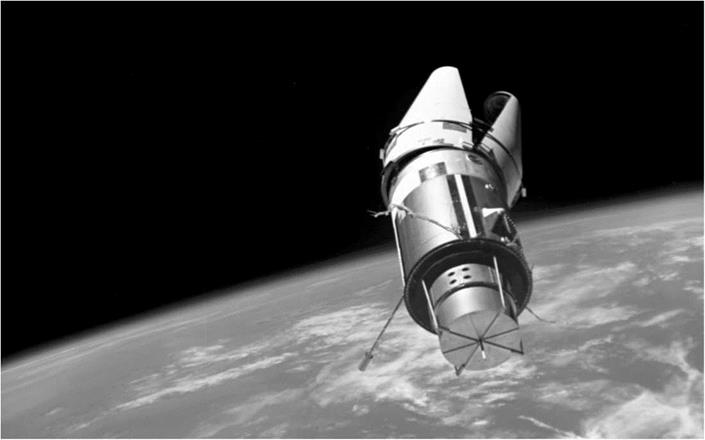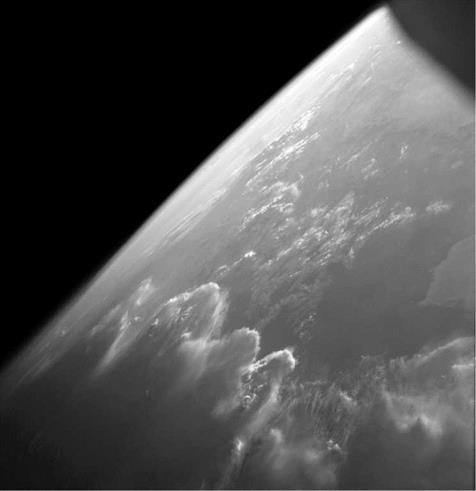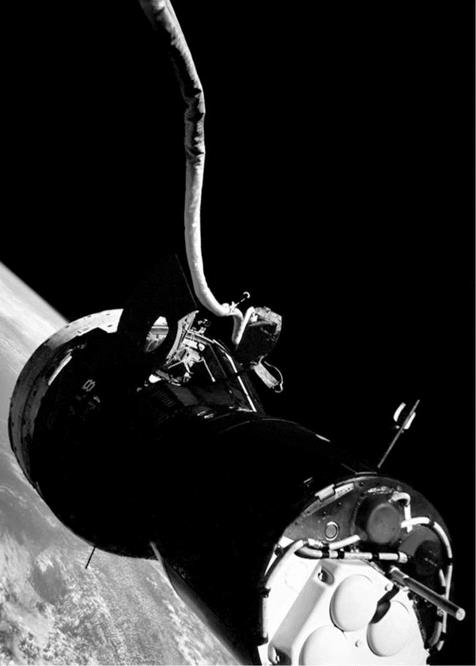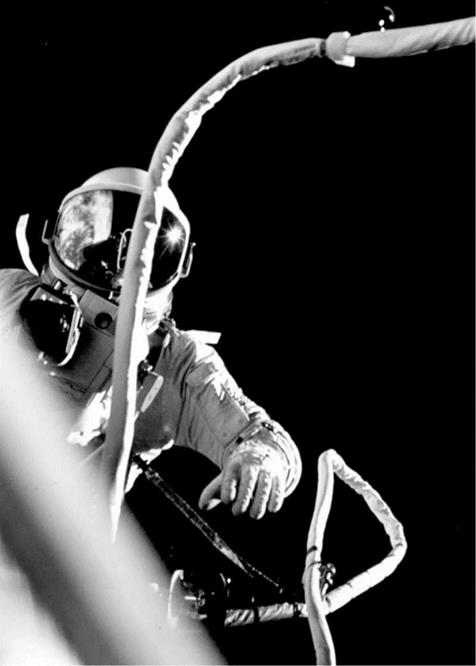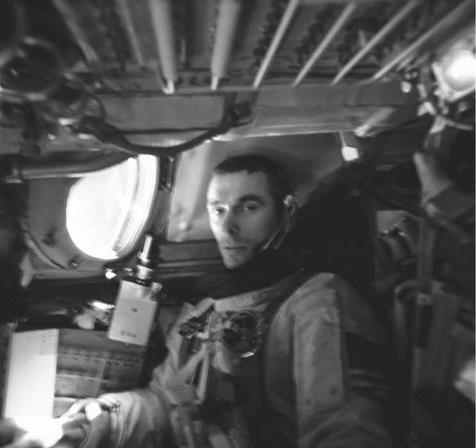Despite the Saturn V’s woes, the situation was somewhat brighter for Spacecraft 101, the command and service module assigned to Apollo 7, the first manned flight. Heavily refurbished and quite different from the machine which had claimed Grissom, White and Chaffee’s lives, it finally arrived at Cape Kennedy on 30 May 1968. By this time, its crew had already been training for more than a year. Commander Wally Schirra, senior pilot Donn Eisele and pilot Walt Cunningham were personally announced before Congress by NASA Administrator Jim Webb on 9 May 1967, with Tom Stafford, John Young and Gene Cernan as their backups. Schirra wanted to call his spacecraft ‘The Phoenix’ – the mythical firebird of classical lore, said to end its 500- year lifespan on a pyre of flames, then return from the ashes – but NASA, fearing unpleasant reminders of Apollo 1, vetoed the idea. Schirra’s crew was also granted a three-man ‘support’ team, drawn from a new pool of astronauts announced in 1966: Jack Swigert, Ron Evans and Bill Pogue. In effect, each Apollo crew would now comprise nine dedicated members, emphasising its complexity over previous Mercury and Gemini missions. In Schirra’s words, the support crew’s role was to ‘‘maintain a flight data file, develop emergency procedures in the simulators and prepare the cockpit for countdown tests’’. Interestingly, Schirra asked Swigert to devise techniques to handle a fuel tank explosion in space. Less than two years after Apollo 7, Swigert would find this task very helpful. . .
From the time that their spacecraft arrived in Florida to the day of their launch on 11 October 1968, Schirra, Eisele and Cunningham would spend nearly 600 hours in the command module simulator, operating the 725 manual controls and responding to countless simulated emergencies and malfunctions. Moreover, they had occupied Spacecraft 101 during an altitude chamber test, had checked out the Chrysler-built slidewire to practice escaping from Pad 34 in the event of a pre-launch emergency, had crawled out of a mockup command module in the Gulf of Mexico and had pored over hundreds of pages of documentation and flight plans.
As Apollo’s first manned flight draws closer, backup senior pilot John Young is inserted into the spacecraft prior to a test at North American’s Downey plant.
North American’s attitude towards the astronauts had changed dramatically, with the company now heartily opening its doors to their inspections, and Schirra, Eisele and Cunningham had not been shy in prowling the Downey plant to check on progress. This irritated Frank Borman, who had been attached to Downey as the astronaut office’s representative. He considered the Apollo 7 crew to be obnoxious and felt that they were just causing disruptions and doing more harm than good. Borman even went so far as to complain to Deke Slayton, who spoke in turn to Schirra. However, it was understandable that the crew behaved as it did: they had seen poor workmanship from North American in the past and three of their comrades had died as a result of it. They wanted to make sure that they would be flying into space in the best possible ship. When Schirra saw an increasingly positive response and commitment from North American, from engineers to managers to the president, Lee Atwood, himself, he was appeased.
On one occasion, Schirra got into trouble himself … albeit to his pleasure. One day in early 1968, he was visiting Downey and, dressed in the required clean-room garb, carefully tried to clamber aboard Spacecraft 101 without damaging any mechanical or electrical parts. “But it was a tight fit,’’ he wrote, “and my knee landed on a bunch of wires. When it did, I felt a sharp slap on my face and I heard a woman’s voice: ‘Don’t you dare touch those wires. Don’t you know we lost three men?’’’ When she found out who Schirra was, the woman was embarrassed and apologetic, but for the commander of Apollo 7, she was just the person NASA needed on its contractor workforce. Schirra’s new-found confidence was shared by John Young, who tracked Spacecraft 101’s progress and concluded that it was ‘‘a pretty clean machine’’.
Elsewhere, fellow astronauts Jim Lovell, Stu Roosa and Charlie Duke simulated how quickly the command module could right itself if it flipped upside down – nose down – in the water (the so-called ‘Stable 2’ position) and for how long it might support them after splashdown. They experienced no difficulties in getting to the manual control switches which inflated three airbags and turned the ship into its upright ‘Stable 1’ orientation. Occasionally, water would splash into the cabin through a post-landing air vent, but the urine collection device proved more than adequate to vacuum this away and dump it overboard. Their consensus: not only was the command module seaworthy, but it could support the astronauts for a prolonged wait of up to two days until recovery. Other astronauts, including Joe Kerwin, Vance Brand and Joe Engle, spent weeks working in test vehicles and concluded that the ship’s systems were virtually trouble-free.
In late July 1968, Schirra, Eisele and Cunningham spent nine hours inside Spacecraft 101 itself under conditions which simulated an altitude of 68.9 km. This gave them the opportunity to perform some of their actual mission tasks and evaluate their ability to work inside pressurised space suits. Technicians purged the cabin, using a mixture of 65 per cent oxygen and 35 per cent nitrogen, then ‘dumped’ the atmosphere so the men were obliged to rely upon their suits as the pressure dropped to almost zero. After an hour in a near-vacuum, the cabin was repressurised with pure oxygen, the normal atmosphere to be used in orbit. A few days later, the backup crew of Stafford, Young and Cernan repeated the exercise with similar success.
For Schirra, it was the altitude chamber testing which ‘sold’ Spacecraft 101 to him. ‘‘I said many times that we would not accept [it] until it had completed its run in the altitude chamber,’’ he wrote, ‘‘similar to the launch pad test where fire killed Grissom, White and Chaffee.’’ The success of these tests prompted him to chortle that Apollo 7 was now on a high-speed track and ‘‘the train is moving out’’.
Spacecraft 101 had begun its manufacturing cycle at North American in early 1966 and, by July of that year, had been assembled, wired, fitted with subsystems and was ready for testing. In the wake of the Apollo 1 fire, it went through a recertification and modification process, during which time its wiring was upgraded and its two-part hatch replaced with the newer unified version. In December 1967, it was finally ready for testing to resume and it passed its three-part acceptance review at Downey in May of the following year. No items were found which might prove ‘‘constraints to launch’’ and on the penultimate day of that month, North American shipped the spacecraft to Cape Kennedy. A flight readiness review in September confirmed that Spacecraft 101 was ‘‘a very good spacecraft”. By that time, wrote Schirra, the crew was ready to go.
For Schirra, Eisele and Cunningham, the events surrounding the Apollo 1 fire and its aftermath were laced with irony. Initially assigned as the prime crew for the original Apollo 2, it had been Schirra’s reluctance to duplicate Gus Grissom’s flight that led him to request its cancellation. In doing so, he had been assigned Apollo 1 backup chores, with no ‘prime’ mission to aspire to. The events of 27 January 1967, in a roundabout way, landed Schirra with the kind of flight he really wanted: something new and challenging. During Apollo 7, he and his crew would spend 11 days in space – the second-longest manned mission to date – and were tasked with the comprehensive and systematic evaluation of the command and service module in Earth orbit.
In theory, Schirra’s mission objectives could be ‘achieved’ in as little as three days, but according to Sam Phillips in a letter to Jim Webb it would be open-ended to 11 days in order ‘‘to acquire additional data and evaluate the aspects of long-duration space flight’’. The countdown, punctuated by three built-in holds to correct any last – minute problems, began on the evening of 6 October and proceeded without incident until ten minutes before launch on the 11th. At that point, thrust-chamber jacket chilldown was initiated for the Saturn’s S-IVB second stage, but took longer than anticipated, forcing a hold of two minutes and 45 seconds. (After launch, analysis confirmed that the chilldown would have occurred without the hold, but waiting, in real time, was prudent in order to meet revised temperature requirements.) The countdown resumed at 10:56 am and the Saturn 1B lifted-off at 11:02:45 am, watched by more than 600 accredited journalists.
If the early stages of the ascent seemed laborious, Time magazine told its readers, they should not have been surprised: the booster weighed 590,000 kg, only slightly less than the 725,750 kg thrust of its first stage. Acceleration from the astronauts’ point of view, therefore, was much calmer and less oppressive than the G loads experienced by previous Mercury and Gemini crews.
Inside the command module, the crew experienced a clear sense of movement, but only Eisele had a good view of the commotion that was going on outside. ‘‘We had a
boost protective cover over the command module,” Cunningham recalled later. “There’s an escape rocket that you can use anytime until you get rid of it, and that’s a little after a minute into the flight. Because that rocket puts out a plume, you had to have a cover over the command module so that you wouldn’t coat the windows and you wouldn’t be able to see anything out of the windows in the event you were coming down on a parachute during an abort. So, the only place you can see out is over Donn’s head in the centre seat. There’s a little round window, about six inches across, and he was the only one that could see out. We had no windows until the boost protective cover [was jettisoned].’’
Two and a half minutes into the thunderous ascent, the eight H-l engines of the Chrysler-built S-IB first stage burned out and it was released, allowing the S-IVB and its single J-2 engine to pick up the thrust and deliver Apollo 7 into orbit. A little under six minutes after launch, as he, Eisele and Cunningham became the first men ever to fly atop a load of liquid hydrogen rocket fuel, Schirra reported that the Saturn was “riding like a dream’’. On the ground, the situation was not quite so dreamy: for a minute or so, the Manned Spacecraft Center had suffered a power failure which temporarily knocked out its lights, control consoles, screens and instruments. Fortunately, generator power took over and no telemetred data was lost.
Despite the successful launch, Schirra would later admit to some anger. Months earlier, during a meeting in Downey, he had learned that Apollo 7 would fly with old Block l-style couches, rather than the improved Block 2 type. The latter, it was realised, would offer better protection for the crew if they happened to inadvertently touch down on land. Schirra felt that if Block l couches had to be used on his flight, the mission rules dealing with wind speeds at launch needed to be revised, since an abort over Florida could push their command module back over land. He agreed to accept Block l couches, on condition that Apollo 7 would not launch if wind conditions were unfavourable. On ll October 1968, winds at the Cape were around 40 km/h, considerably higher than the maximum-allowable 32 km/h needed to avoid a touchdown on land. It was felt that the Saturn lB’s record of reliability made it unlikely that an abort would occur in the early stage of ascent, but to Schirra, commanding the crew that would be flying the thing, it was black and white. “A mission rule had been broken,’’ he wrote. “Needless to say, I was not the happiest guy in town.’’
Ten and a half minutes after launch, following little bumpiness and loads which never exceeded l G, Apollo 7 was inserted perfectly into an orbit of 227-285 km and the S-IVB duly shut down. Both stages of the Saturn performed to near-perfection. Two hours and 55 minutes into the flight, the spacecraft undocked from the S-IVB and pulsed its reaction controls twice to turn back in a simulated rendezvous approach which Moon-bound crews would use to pick up their lunar module. Although there was no lunar module housed inside the stage, it provided useful practice and Schirra brought his ship within l.2 m of the spent S-IVB. Unfortunately, said Cunningham, one of the four adaptor panels had not fully deployed, due to a stuck retention cable, although they would be jettisoned explosively on subsequent flights to ensure lunar module extraction. It “had sort of
|
Apollo 7’s S-IVB third stage during station-keeping operations.
|
bounced back,” wrote Deke Slayton. “It posed no danger to the crew, but had this flight carried a lunar module, it might have been tough to get it out of there.”
Elsewhere, the performance of the big SPS engine was highly successful. It was fortunate, indeed, that this was the case, for this was a component which simply ‘had to work’ or lunar crews would not be able to return home. During their mission, Schirra, Eisele and Cunningham oversaw no fewer than eight SPS firings, the first of which posed something of a surprise. In contrast to the exceptionally smooth Saturn IB liftoff, the SPS noticeably jolted the astronauts, prompting Schirra to whoop ‘‘Yabadabadoo!’’ in imitation of Fred Flintstone. Eisele, too, said that the entire crew ‘‘got more than we expected’’ and that the additional boost literally plastered them back into their seats. Eater SPS burns lasted anywhere from half a second to more than a minute in duration and simulated virtually everything from a return from the Moon to a rendezvous with a phantom lunar module.
Other systems aboard Apollo 7 performed equally well. Occasionally, one of the three electricity generating fuel cells would develop unwanted high temperatures, but load-sharing hookups prevented any power shortages. The astronauts complained about noisy fans in the environmental circuits and turned one of them off, but, when this did not help, switched off the other. Visibility through the windows was mixed, with sooty deposits noted shortly after the jettisoning of the Saturn IB’s escape tower and spots of water condensation seen at other times. Two days into the flight, however, Cunningham reported that most of the windows were in fairly good condition, although moisture was gathering between the inner panes in one case. A similar situation was seen by Schirra a few days later. Nonetheless, the windows proved adequate, particularly during the rendezvous and station-keeping with the S – IVB, when they were almost clear. Navigational sightings with a telescope and sextant on any of 37 pre-selected stars proved difficult if done too soon after a wastewater dump and, indeed, the astronauts typically had to wait several minutes for the frozen droplets to disperse. Eisele reported that unless he could see at least 40 or 50 stars at a time, it was tough to decide which part of the sky he was looking at.
On a more mundane level, the ‘waste-management system’ – a somewhat euphemistic term for Apollo’s rudimentary toilet – proved adequate, if annoying. Its defecation bags, which contained a blue germicidal tablet to prevent bacterial and gas formation, could be sealed easily and stored in empty food containers in the command module’s lower equipment bay. However, they were far from ideal, still produced unpleasant odours and took each astronaut 45-60 minutes to complete. Bill Anders, who flew Apollo 8, would later tell Andrew Chaikin that, since nothing in microgravity ‘falls’, it was necessary to ‘‘flypaper this thing to your rear end and then reach in there with your finger [the bags had ‘fingers’ for this] – and suddenly you were wishing you’d never left home!’’ To add insult to injury, the germicidal tablets then had to be kneaded into the contents of the defecation bag to ensure that they were fully mixed. Not surprisingly, many astronauts found themselves postponing their ‘need to go’ for as long as possible and particularly to wait until there was no work to do.
The urine-collection device took the form of a hose with a condom-like fitting on the end, which led, by way of a valve, to a vent on the outside of the command module, out of which would periodically spill a cloud of frozen droplets. (One Apollo astronaut, when asked what he thought was the most beautiful sight in space, responded “Urine dump at sunset!”) During one toilet session, as Cunningham fitted the urine hose to his suit, he instinctively turned his back to the window for privacy. “Walt,” Schirra asked with some humour in his voice, “who is out there?”
As for moving around in the new spacecraft, the astronauts turned, in Schirra’s words, into spacegoing gymnasts. “You can move any place you want to fairly freely,’’ said Cunningham, “and you certainly don’t need strong handholds to take care of it.’’ Exercise was important, though. At first, when they slept in their couches, their bodies curled up into foetal positions, giving them lower back and abdominal pains; these were relieved by working on a stretching device called an Exer-Genie, which relaxed their cramped and aching muscles.
Sleep brought mixed blessings, with Schirra complaining about the around-the – clock operations which disrupted their normal routine. Sometimes they might go to bed as early as 4:00 pm or as late as 4:00 am, he said, and a consensus was finally reached whereby Eisele kept watch on Apollo 7’s systems whilst Schirra and Cunningham slept and vice versa. Two sleeping bags were mounted beneath the couches and the astronauts typically zipped themselves inside, although the incorrect positioning of restraint straps made them less than ideal. Cunningham, certainly, preferred to sleep in his couch with a shoulder harness and lap belt to keep still. However, if two crew members did this, they invariably disturbed their colleague who was awake. By the third day of the flight, thankfully, they had worked out a routine to get enough sleep.
All three men expressed unhappiness over their food, which tended to crumble and whose particles floated around the cabin. Following his Gemini VI-A mission three years earlier, Schirra requested taking coffee with him aboard Apollo, which he did. Not so fulfilling were the head colds which, first Schirra, and then Eisele and Cunningham, developed during the mission. To be fair, this caused severe discomfort, because it proved extremely difficult to clear the ears, nose and sinuses in microgravity. Mucus rapidly accumulated, filling their nasal passages and stubbornly refusing to drain from their heads; indeed, their only relief was to blow their noses hard, which proved painful on their ear drums. A little under a day into the mission, an irritable Schirra, already annoyed that Mission Control had added two thruster firings and a urine dump to their workload, cancelled the first planned television transmission from Apollo 7, “without further discussion’’. It was the first of many conflicts with ground staff.
Indeed, according to Schirra in his autobiography, Donn Eisele, watching over the spacecraft systems at the time, began the dispute with Mission Control over rescheduling the first television transmission early on 12 October. “When I awoke,’’ Schirra wrote, “I could hear Eisele in an argument. I put on a headset and heard a ground controller say, rather insistently, that our first television transmission was on the agenda for that day.’’ Schirra butted in and backed Eisele that they had enough to do on their second day in orbit, with engineering objectives, rendezvous practice and SPS preparations, without having to worry about the transmission. However, there was more to it than that. “We were scheduled to test the TV circuit later that day,” explained Schirra, “and we’d test it before using it. It was an electrical circuit and I had not forgotten than an electrical short had resulted in the loss of the Apollo 1 crew.’’
In fact, Schirra had complained about the scheduling of the transmissions on the ground, before launch, “but hadn’t been able to win the battle,’’ wrote Deke Slayton. “He probably figured there wasn’t much we could do to him while he was in orbit, and he was right, but it made my life kind of difficult.’’ The commander’s antics also upset the flight directors, including Chris Kraft and Glynn Lunney, when he began sarcastically criticising “the genius’’ who designed a particularly balky piece of equipment. “He might have been right,’’ continued Slayton, “but it sure didn’t endear him to the guys on the ground to have the astronaut implying they were idiots over the open line for everyone to hear.’’ Eisele and Cunningham, despite their admonitions to the contrary, followed Schirra’s lead. After one test which he perceived as pointless, Eisele, clearly annoyed, quipped that he “wanted to talk to the man, or whoever it was, that thought up that little gem’’. ‘The man’ turned out to be Flight Director Lunney himself. Going over the mission tapes and transcripts after the flight, Cunningham would conclude that he ‘‘never had any problem with the ground’’, although Deke Slayton felt that all three men ‘‘were pretty testy’’. One flight controller even muttered, only half-jokingly, about letting the Apollo 7 crew land in the middle of a typhoon . . .
Still, on the third day of the mission, the first of seven eagerly awaited transmissions began, marking the first live televised event from an American manned spacecraft. Each one took place as Apollo 7 passed between Corpus Christi in Texas and Cape Kennedy, the only two ground stations equipped to receive the transmissions. The crew opened the first telecast with a sign which read ‘From the lovely Apollo room, high atop everything’, then aimed their camera through the window as they passed above New Orleans and over Florida. Later transmissions included tours of the command module, demonstrations of the Exer-Genie and explanations of how food was prepared in space and how dried fruit juice was reconstituted with water. All in all, the telecasts were well-received and the astronauts enjoyed them, displaying cards with ‘Keep Those Cards and Letters Coming In, Folks’ . . . and offering Schirra a chance to gain revenge on Deke Slayton by asking him, live, if he was a turtle. Sitting in Mission Control, the gruff Slayton acknowledged that he had recorded his answer, switching off his microphone to utter the necessary answer: ‘‘You bet your sweet ass I am!’’ After the flight, these ‘Wally, Walt and Donn Shows’ proved so popular that the astronauts even won a special Emmy award.
By 12 October, the day that Schirra cancelled the first transmission, Apollo 7 had drifted about 130 km from the S-IVB. The crew’s task was to re-rendezvous with it. This was not as straightforward as it had been on Gemini, since the command module lacked a rendezvous radar and the astronauts were unable to read their range and closing velocity to the target. However, wrote Schirra, ‘‘we made it through the rendezvous, with each of us ageing about a year’’, and Apollo 7 edged to within 20 m of the discarded stage. The manoeuvre proved quite traumatic, with no clear awareness of their closing motions, and the S-IVB itself was spinning throughout like an angry whale. Twenty metres was close enough, before moving away. The stage eventually re-entered the atmosphere on 18 October, its debris splashing into the Pacific Ocean.
Experimental work included synoptic terrain photography, employing a handheld 70 mm Hasselblad 500C camera to monitor the Carolina bays in the United States and examine wind erosion in desert regions, tropical morphology and the origin of the African rift valley. Imagery was also acquired of Baja California, parts of Mexico and the Middle East in support of geological inquiries and geographical urban studies were aided by photographs of New Orleans and Houston. Islands in the Pacific, extensive coverage of northern Chile and Australia and other areas added to Apollo 7’s photographic haul. Overall, that haul amounted to some 500 images, of which more than a third proved usable, although the need to change film magazines, filters, settings and keep cameras steady accounted for the improper exposure of many frames. Weather photography was also important, with numerous images of various cloud and meteorological structures, including the best-ever photographs of a tropical storm, in this case Hurricane Gladys and Typhoon Gloria. Pre-flight and post-flight X-rays of bones also contributed towards a demineralisation study, whilst sampling before launch and after splashdown helped to determine cellular changes in the astronauts’ blood.
The final days of what both Wernher von Braun and Sam Phillips were lauding as “the perfect mission’’ were marred by the worsening head colds. Schirra’s, indeed, had materialised barely 15 hours after launch, forcing him to admit that he had “gone through eight or nine Kleenexes’’, so he had to endure it for most of the 11- day mission. (He also took Actifed, to which he became so attracted that he helped sell it on television commercials after leaving the astronaut corps.) Years later, Walt Cunningham would blame Schirra’s cold on a dove-hunting trip that the Apollo 7 crew took in a rainy Florida shortly before launch. “Wally was kind of a General Bull Moose complex,’’ Cunningham said. “What’s good enough for Bull Moose is good enough for the world. So, when Wally had a cold, everybody had to be miserable.’’
A head cold anywhere is miserable, but in the pressurised confines of a spacecraft, it proved much more so, and Eisele and Cunningham quickly succumbed. Physician Chuck Berry advised them to take aspirin and decongestant tablets and, as re-entry neared, they began to worry that the build-up of pressure whilst wearing their helmets might burst their eardrums. ft was not an idle fear. During his days at test pilot school, Schirra had made a short flight in a propellor aircraft, with a head cold, and “almost busted an ear drum’’. The choice he now faced on Apollo 7 – not wearing a helmet or running the risk of lifelong hearing loss – was an easy one to make.
Deke Slayton explicitly ordered the crew to wear their helmets, but Schirra refused, agreeing only to keep them stowed in case of emergencies. There were, admittedly, contingency options in place for returning home suitless, perhaps in the event of contamination, but after almost 11 days it seemed unlikely that cabin pressure would fail during re-entry. Each man took a decongestant pill an hour before hitting the atmosphere and endured no major problems. As the command module’s pressure was raised to conditions approximating normal sea-level, Schirra,
Eisele and Cunningham performed the Valsalva manoeuvre – holding their noses, closing their mouths and vigorously exhaling through their nostrils – to keep their middle ears equal to the increasing cabin pressure. In doing so, they avoided ruptured ear drums… but aroused the wrath of flight controllers. All three men would be “tarred and feathered” for their insubordination during the mission. Schirra had already announced his retirement from NASA and probably could not have cared less, but Eisele and Cunningham, who had followed their commander’s lead, would never fly again.











